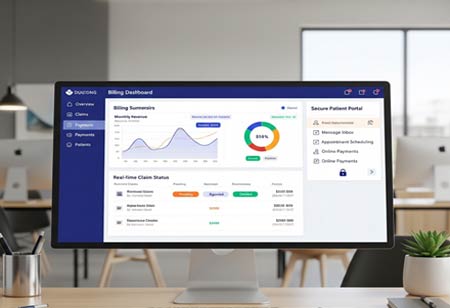Thank you for Subscribing to Healthcare Business Review Weekly Brief
Be first to read the latest tech news, Industry Leader's Insights, and CIO interviews of medium and large enterprises exclusively from Healthcare Business Review
Medical Billing Services: Adapting to Healthcare's Dynamic Landscape
Medical billing evolves into a strategic function, blending technology, transparency, and agility to meet modern healthcare's operational and regulatory demands.

By
Healthcare Business Review | Tuesday, September 16, 2025
Stay ahead of the industry with exclusive feature stories on the top companies, expert insights and the latest news delivered straight to your inbox. Subscribe today.
A strategic transition is underway within the medical billing services industry, shifting its role from backend administration to central infrastructure in healthcare operations. The sector now responds to deeper demands: technological precision, regulatory resilience, and operational transparency. What was once transactional has become relational, involving providers, payers, and patients in a tightly interwoven system of data, trust, and financial clarity.
Changing expectations around pricing visibility, service customization, and digital access are challenging legacy models. In response, billing providers are deploying scalable frameworks built on speed, accuracy, and embedded compliance. The path forward demands more than technical upgrades; it requires agile transformation aligned with healthcare's evolving rhythm. Innovation is no longer an enhancement; it is the foundation of sustained relevance in a changing medical economy.
Automation and Intelligence Take Center Stage
The incorporation of automation and artificial intelligence into routine processes is the most obvious development affecting medical billing services. The adoption of predictive tools has allowed companies to identify patterns in claim denials, process errors, and payment delays before they become financial risks. These platforms enable providers to optimize their workflows by flagging issues early in the revenue cycle. In effect, automation reduces the margin for error and expedites once labor-intensive billing tasks.
Equally transformative is the increased use of robotic process automation for functions such as claims entry, insurance verification, and remittance posting. These are now being handled in milliseconds, not minutes, freeing human resources to focus on more strategic areas like compliance tracking and patient communication. Cloud-based platforms provide real-time synchronization of billing data, allowing access across various locations and teams. This accessibility ensures that information remains consistent, which is essential for collaborative revenue cycle management.
Patient engagement tools are also emerging as quite disruptive. From interactive portals to mobile billing alerts, these tools help bridge the gap between the administrative and personal aspects of healthcare. Billing has traditionally been one of the least patient-friendly areas of the healthcare journey, but intuitive platforms are changing that. By offering greater visibility into balances, payment options, and explanations of charges, these tools foster trust and reduce the likelihood of delayed collections or disputes.
Challenges Spark Innovation in System Design
Despite advancements, the medical billing services sector continues to grapple with a range of operational and regulatory challenges. Fragmented data systems, frequent policy changes, and varying reimbursement models all contribute to the difficulty of maintaining consistency across multiple client types. Errors in coding, misinterpretation of payer rules, and delayed updates in regulatory requirements can create bottlenecks that affect both revenue and patient satisfaction.
Data security and privacy remain major concerns, particularly as billing platforms become more interconnected. With the increasing flow of sensitive health and financial data between systems, the risk of breaches and compliance lapses grows more acute. In response, many firms are adopting advanced encryption protocols, multifactor authentication, and secure data transmission standards as baseline infrastructure. These safeguards are becoming standard requirements rather than value-added features, reinforcing the importance of trust in financial transactions related to healthcare.
Interoperability is also being approached with renewed urgency. Medical billing systems are being redesigned to integrate more smoothly with electronic health records, practice management platforms, and payer portals. This seamless flow of data not only improves billing accuracy but also reduces administrative burden across the healthcare spectrum. Machine learning models are increasingly being used to recommend coding adjustments based on historical claim behavior and payer-specific tendencies, reducing the manual review required for claim optimization.
A Platform for Strategic Growth and Value Creation
Challenges have prompted innovation and created fertile ground for new opportunities. As billing systems become more intelligent and interconnected, stakeholders now have access to real-time performance insights that can inform broader business decisions. Dashboards and analytics tools offer detailed views into payer response times, claim aging trends, and overall financial health. This kind of visibility transforms billing data from a lagging indicator into a strategic planning asset.
The shift to value-based care also opens new doors for billing providers willing to adapt. Traditional fee-for-service billing workflows are being redesigned to accommodate bundled payments, quality-based reimbursements, and outcome tracking. Providers now expect billing services to help them track quality metrics, ensure proper incentive payments, and navigate shared savings programs. This evolution extends billing's reach into the realm of strategic alignment with care delivery.
Scalability has become a key advantage in the modern billing ecosystem. Cloud infrastructure, modular systems, and customizable interfaces allow providers to scale services according to practice size, specialty, and location. This flexibility has positioned medical billing firms as critical enablers of growth for both small practices and large healthcare organizations. As the healthcare landscape continues to diversify, the ability to meet varying needs without system overhauls becomes a strategic differentiator.
Across this evolving landscape, one thing remains clear: the function of medical billing has outgrown its back-office roots. It now sits at the intersection of operational performance, patient experience, and regulatory compliance. Organizations that can deliver transparency, precision, and adaptability through their billing processes will be positioned not only to survive the market shifts but to shape them.






